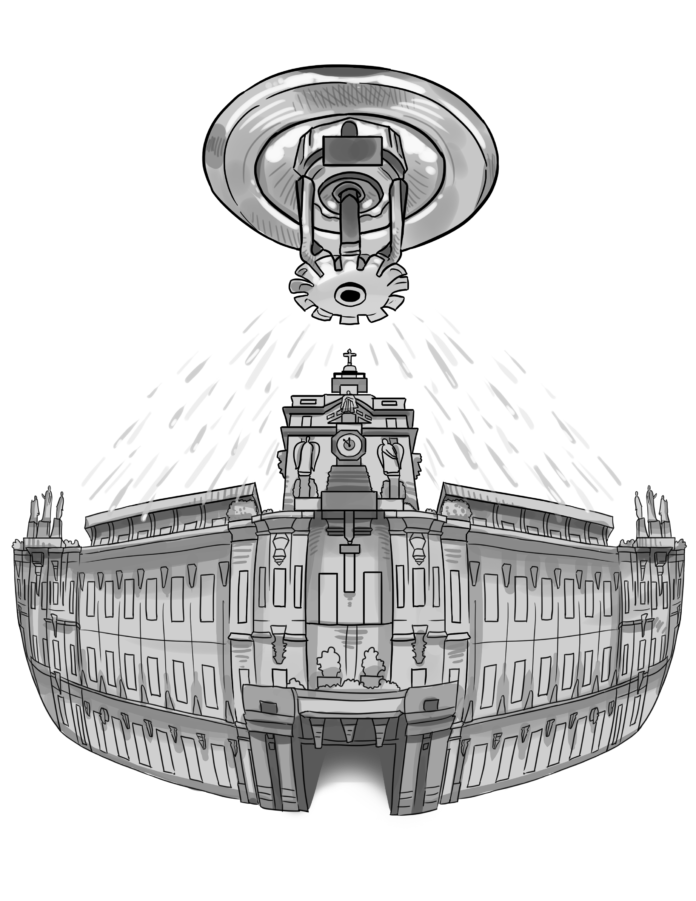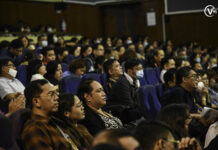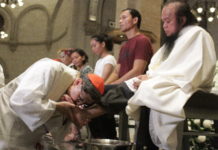FIRE incidents inside the University will soon be addressed with the installation of Automated Fire Sprinkler Systems in various buildings, Rector Fr. Herminio Dagohoy, O.P. has bared.
“The University’s next project is [to place sprinklers in the old buildings because] a lot of buildings do not have sprinklers yet,” Fr. Dagohoy told the Varsitarian.
In-house mechanical engineer Antonio Espejo of the Facilities Management Office (FMO) noted the absence of sprinklers in St. Raymund de Penafort Building, which caught fire in July last year. The FMO installed more fire extinguishers in the building after the incident.
In a report on the fire incident, John Joseph Jalique, head of the investigatory unit of the Manila Fire Department, said the damage caused by the fire could have been minimized if there were sprinklers inside the building.
Required by law
Republic Act 9512, or the Comprehensive Fire Code of the Philippines, states that establishments constructed after the law’s implementation in 2008 are required to install sprinklers.
In 2011, the Bureau of Fire Protection (BFP) gave a two-year grace period for buildings to install sprinklers. Establishments that did not meet the grace period should provide an alternative to make up for the absence of sprinklers, with the approval of the BFP.
The Buenaventura Garcia Paredes O.P. building, Beato Angelico building, Thomas Aquinas Research Complex and Quadricentennial Pavillion are the only structures in the University with sprinklers installed. Construction of these buildings were finished in the years 2014, 2008, 2007 and 2011, respectively.
Although the law allows alternatives, installing sprinklers is recommended because fire extinguishers only have a short-term effect in suppressing fire, Jun Parena, a volunteer from the Manila Fire Department said.
However, Parena said the designs of edifices like the Main Building, which was built in 1927, would make installation difficult.
“It could be very hard for us to have sprinklers, especially in the older buildings. Because [the piping systems required to build the sprinklers] are not integrated into the designs [of the building],” Parena said in an interview.
Parena, who is also an applied math instructor in the College of Science, said there were other issues to be addressed.
“We have a [low culture of safety],” Parena said, pointing out that the cause of the fires in the Main Building and St. Raymund de Penafort Building, in 2012 and 2015 respectively, were office appliances that were left running.
He also said the students’ lack of awareness with safety protocols accounted for their hard time in distinguishing between a fire and an earthquake drill.
“[Preparing for] the fire scenario is just secondary to the earthquake. So that’s the reason why sometimes it would be hard for students to actually discern between [an earthquake or a fire drill], because it depends on the siren that you are using and the response,” Parena said.
The Main Building has a building-wide fire drill once every term.
Parena said the University should at least conduct four safety drills per year.
Installing safety cabinets, strictly complying with fire drills and encouraging students to join fire volunteer work can contribute to promoting fire safety, aside from adding sprinklers, Parena said.
Dagohoy bared to the Varsitarian the administration’s plan to rewire the main building, which may cost P85 million. However, the Rector is asking UST’s Economic Council to reconsider the costs.
“I told the UST Economic Council to [review the costs]. We’ll see if it will really cost [P85 million],” Dagohoy said. With reports from Paul Xavier Jaehwa C. Bernardo




















